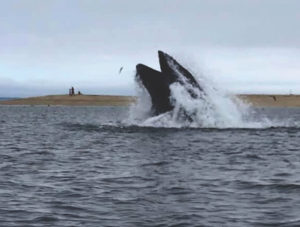This past week saw more evidence of the effects of global warming on our oceans. We continue to see more warm-water fish moving up into our area. Charter boats out of Rock Harbor and Sesuit Harbor are reporting catches of albacore tuna on the south end of the bay. There was also a report of a white marlin being caught off the backside of Provincetown. Black sea bass have moved as far north as the middle of Cape Cod Bay, and the guys flounder fishing off Wellfleet Harbor are catching more and more of them.

There are few better-tasting fish in the ocean than black sea bass. It would be awesome if we eventually can catch them around our harbor. I believe that will happen in the not too distant future.
Flounder fishing remains good and they are underfished, much to the delight of the few guys doing it. In this next decade, catches of black sea bass, triggerfish, mahi, albacore, wahoo, and yellowfin tuna will become more common in and around our waters, if our planet continues to heat up.
Bluefish have been around, but not in great numbers. The bluefish hanging around Race Point remain rather small, while the south end of the bay by Barnstable has seen the jumbos. One day there was a showing of big bluefish off the Mission Bell on the backside beach, but the next day they were gone.
Striped bass fishing has been fairly consistent around Race Point. Drifting whole mackerel, pogies, or herring is still the most effective way to catch them. They have been going back and forth between Race Point and the Coast Guard station on the ocean side. Small bluefish have been mixed in with them, and, occasionally, there is a bonito blitz in the same area. We have two distinctly different groups of bonito right now. One is the small snapper-sized bonito, and the other is larger: two- to four-pound fish.
There are huge schools of pogies in our harbor, and that has brought both whales and giant tuna inside to consume them. There was a spectacular show of humpback whales between the breakwater and Long Point last week, bubble-cloud feeding on the pogies. There are not a lot of places in the world where one can observe such a magnificent sight so close to shore.
Speaking of tuna, fishing for them was good last week in the bay and also on Stellwagen Bank. From what I hear, the market has also improved somewhat, although the price is still depressed.
We are waiting to see if we get a fall striped bass run, as the fish to our north begin their southern migration back to Chesapeake Bay. It’s been four years since we had a fall run, as the fish have taken different routes and bypassed us. Time will tell.
While we grapple with our out-of-control seal population and culling remains off the table in the U.S., Canada is having a seal fest. The Seals & Sealing Network’s Seal Fest is in its third year, taking place from Sept. 10 to 19. Restaurants in Montreal, Quebec City, Toronto, and St. John’s are featuring chef-prepared seal dishes. Seal is recognized as a wild, eco-friendly alternative protein in Canada. Both harp and gray seals are listed as “smarter seafood” by Exploramer, a certification program that ensures Canadian marine resources are managed and used responsibly.
There are always at least two sides to every issue.
